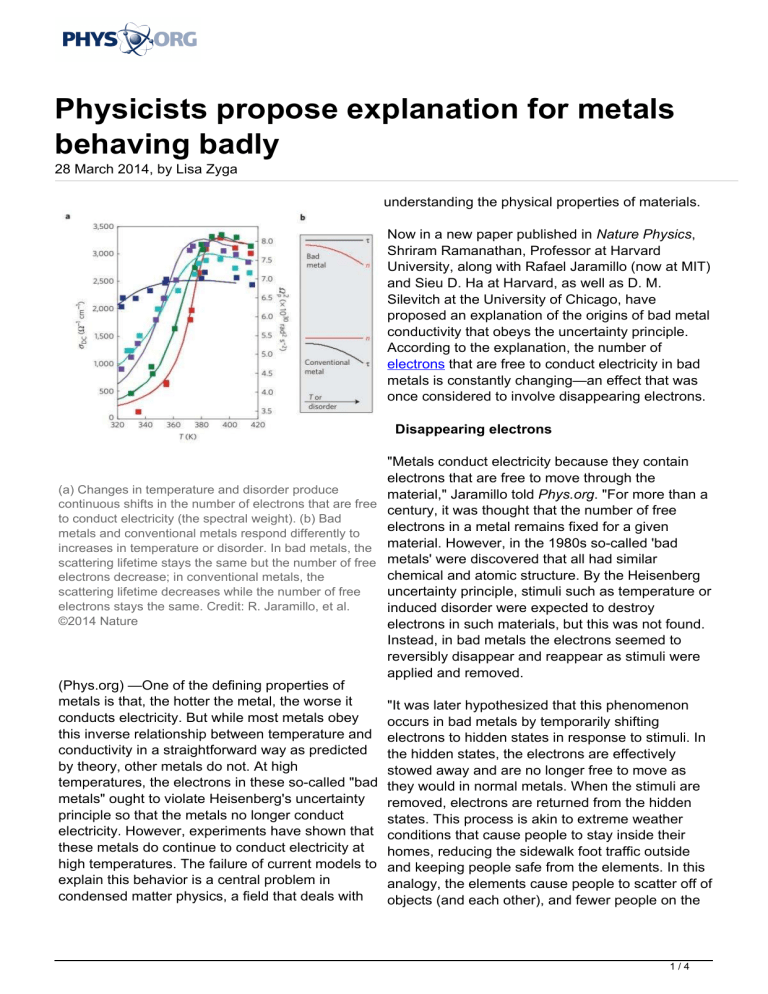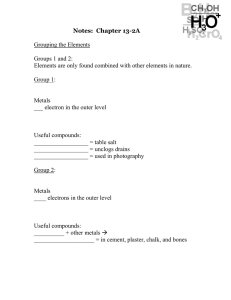
Physicists propose explanation for metals
behaving badly
28 March 2014, by Lisa Zyga
understanding the physical properties of materials.
Now in a new paper published in Nature Physics,
Shriram Ramanathan, Professor at Harvard
University, along with Rafael Jaramillo (now at MIT)
and Sieu D. Ha at Harvard, as well as D. M.
Silevitch at the University of Chicago, have
proposed an explanation of the origins of bad metal
conductivity that obeys the uncertainty principle.
According to the explanation, the number of
electrons that are free to conduct electricity in bad
metals is constantly changing—an effect that was
once considered to involve disappearing electrons.
Disappearing electrons
"Metals conduct electricity because they contain
electrons that are free to move through the
(a) Changes in temperature and disorder produce
material," Jaramillo told Phys.org. "For more than a
continuous shifts in the number of electrons that are free
century, it was thought that the number of free
to conduct electricity (the spectral weight). (b) Bad
electrons in a metal remains fixed for a given
metals and conventional metals respond differently to
increases in temperature or disorder. In bad metals, the material. However, in the 1980s so-called 'bad
scattering lifetime stays the same but the number of free metals' were discovered that all had similar
chemical and atomic structure. By the Heisenberg
electrons decrease; in conventional metals, the
scattering lifetime decreases while the number of free
uncertainty principle, stimuli such as temperature or
electrons stays the same. Credit: R. Jaramillo, et al.
induced disorder were expected to destroy
©2014 Nature
electrons in such materials, but this was not found.
Instead, in bad metals the electrons seemed to
reversibly disappear and reappear as stimuli were
applied and removed.
(Phys.org) —One of the defining properties of
metals is that, the hotter the metal, the worse it
"It was later hypothesized that this phenomenon
conducts electricity. But while most metals obey
occurs in bad metals by temporarily shifting
this inverse relationship between temperature and electrons to hidden states in response to stimuli. In
conductivity in a straightforward way as predicted the hidden states, the electrons are effectively
by theory, other metals do not. At high
stowed away and are no longer free to move as
temperatures, the electrons in these so-called "bad they would in normal metals. When the stimuli are
metals" ought to violate Heisenberg's uncertainty
removed, electrons are returned from the hidden
principle so that the metals no longer conduct
states. This process is akin to extreme weather
electricity. However, experiments have shown that conditions that cause people to stay inside their
these metals do continue to conduct electricity at
homes, reducing the sidewalk foot traffic outside
high temperatures. The failure of current models to and keeping people safe from the elements. In this
explain this behavior is a central problem in
analogy, the elements cause people to scatter off of
condensed matter physics, a field that deals with
objects (and each other), and fewer people on the
1/4
sidewalk makes walking easier for those that
remain."
answer to this question by performing experiments
on a new class of bad metals, the rare-earth
nickelates—in particular, SmNiO3 (samarium
nickelate). In their experiments, the scientists grew
Scattering to the limit
a series of samples of samarium nickelate by highpressure sputtering, controlling the amount of
Similar to how strong winds blow pedestrians
around, high temperatures cause the electrons in a disorder in each sample by varying the sputtering
metal to scatter more rapidly than they do at lower pressure.
temperatures. The increased disorder causes a
decrease in the metal's conductivity. This effect is Then the researchers measured the conductivity of
called the scattering rate hypothesis and is part of each sample at different temperatures, and also
the Drude model of electrical conduction, which has compared the results to the conductivities of
been used to describe metal conductivity for more conventional metals from published data.
than a century.
The physicists found that temperature (and
According to Heisenberg's uncertainty principle, this disorder) does not affect nickelates in the same
way as it affects conventional metals. Whereas in
inverse relationship between conductivity and
temperature cannot continue indefinitely. When the conventional metals, changes in temperature and
temperature exceeds a certain point, the electrons disorder affect the scattering rate of electrons as
are predicted to scatter off one another so quickly explained above, in nickelates, changes in
temperature and disorder produce continuous shifts
that they should no longer have a well-defined
energy. So the uncertainty principle places a limit in the number of electrons that are free to conduct
on the time between scattering events (called either electricity (the spectral weight).
the scattering lifetime or the mean free time
This finding leads to the most important result of
between collisions), and thus on a metal's
the paper: Redistributions in the nickelates' spectral
maximum temperature.
weights enable them to remain conductors at high
For most metals, this limit isn't a problem because temperatures while preserving the Drude model
and without violating the uncertainty principle.
they start to melt long before they reach this high
Going back to the analogy of pedestrians bumping
temperature. Other metals, called saturating
into each other on the sidewalk, the fewer
metals, don't melt but still obey the limit because
pedestrians (electrons), the less frequently they
their conductivity saturates as they approach the
bump into each other. The time between electron
limit, validating that the conductivity-temperature
scattering events is long enough to not violate the
relationship does not continue indefinitely.
uncertainty principle.
However, experiments have shown that bad metals
The researchers' observations suggest that the
can exceed this temperature without melting or
exhibiting conductivity saturation. Instead, the bad changes in spectral weight occur due to
interactions between electron-phonon interactions
metals remain conductors even at high
in nickelates. However, they caution that it will be
temperatures at which the scattering hypothesis
challenging to develop a theory that fully describes
predicts violation of the uncertainty principle.
these interactions.
Fewer free electrons
Bad metals, promising futures
If, as Jaramillo explained above, bad metal
Nickelates aren't the only materials known to exhibit
behavior is caused by electrons that seem to
spectral weight shifting; the effect is also seen in
disappear and reappear, what causes these
Mott-Hubbard materials, which also behave slightly
disappearances?
differently than conventional theories predict. By
showing that bad metal conductivity can be
In the new paper, the physicists proposed an
2/4
explained by the shifting of spectral weight in
nickelates, the results here provide a deeper
understanding of electrical conductivity and help
explain why some metals don't behave as
obediently in accordance with standard theories as
other metals do.
"Bad metal behavior seems to go hand-in-hand with
some of the most poorly understood but
technologically promising phenomena in physics,
such as high-temperature superconductivity and
colossal magnetoresistance," Jaramillo said. "Many
of the same materials that exhibit these effects also
turn out to be bad metals. Any advance that sheds
light on bad metals therefore impacts a large swath
of solid state physics, including a number of
technologically promising materials.
"On a more fundamental level, understanding
metals formed the core of 20th century solid state
physics. From Drude's theory, to quantum
mechanics and Bloch states, and culminating in
Lev Landau's profound Fermi liquid theory,
physicists have probably had a deeper
understanding of metals than any other solid state.
Therefore, an outstanding puzzle like bad metals is
galling and really calls out for deeper
understanding."
In the future, the physicists plan to study bad
metals in more detail to better understand their
unusual behavior.
"Future research directions would include
investigating the role of strain and chemical
disorder in bad metals," Jaramillo said. "For
example, it would be fascinating to compare the
response of a bad metal to different types of
disorder, such as structural disorder and ion
implantation."
More information: R. Jaramillo, et al. "Origins of
bad-metal conductivity and the insulator-metal
transition in the rare-earth nickelates." Nature
Physics. DOI: 10.1038/NPHYS2907
© 2014 Phys.org. All rights reserved.
APA citation: Physicists propose explanation for metals behaving badly (2014, March 28) retrieved 30
September 2016 from http://phys.org/news/2014-03-physicists-explanation-metals-badly.html
3/4
This document is subject to copyright. Apart from any fair dealing for the purpose of private study or research, no
part may be reproduced without the written permission. The content is provided for information purposes only.
4/4
Powered by TCPDF (www.tcpdf.org)








